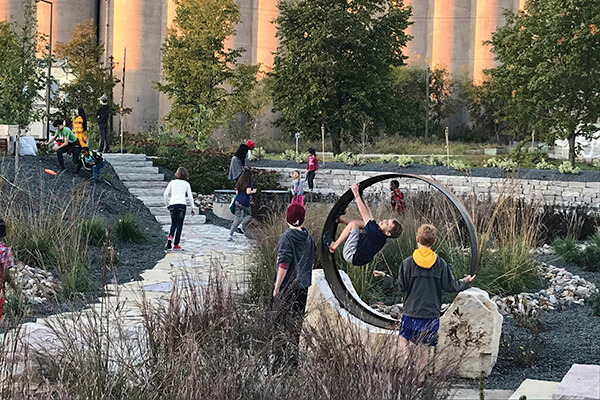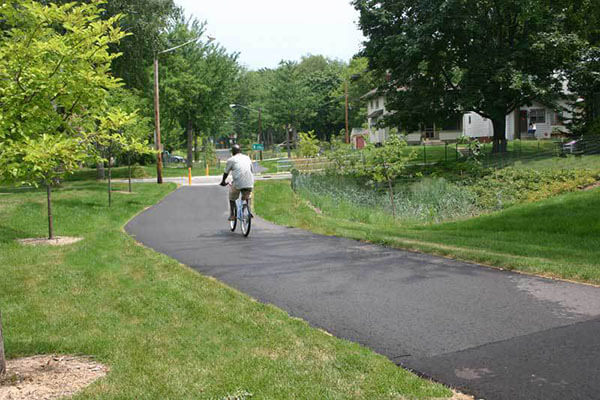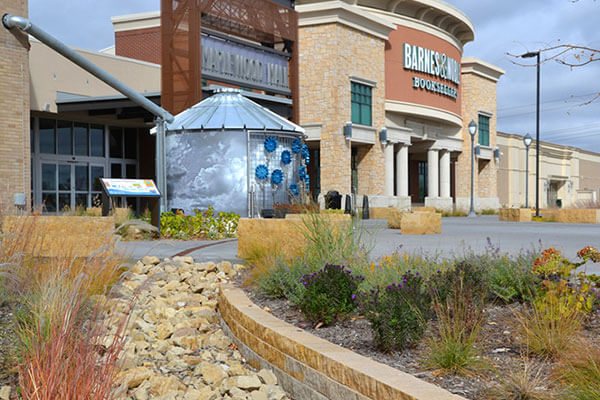Imagine that you need to manage stormwater, beautify a space, and create a place where the neighborhood can meet and play—but you only have a tiny scrap of land available. How do you choose what to do with it?
According to landscape architect Marcy Bean and water resources engineer Nathan Campeau, you don’t have to choose at all. You can accomplish all those goals in a small space with a stacked-benefits project involving green infrastructure and low-impact, integrated stormwater management.
"We can change how spaces are physically used by people while also managing stormwater. You can do a lot in a small amount of space and meet multiple goals from different types of organizations."
Marcy and Nathan both came into green infrastructure and urban redevelopment little by little. Besides being a landscape architect, Marcy is a project manager, working green infrastructure into parks for watershed and city clients. Nathan works on anything related to surface water, but also does a lot with green infrastructure and park design, which is where his work intersects with Marcy’s.
Nathan finds himself drawn to “projects that interface with the public realm,” he says. “What really drives me is how the work I do can beautify the public realm and expand on it in really interesting ways. Stormwater and flood control are not separate things, but are fully integrated into whatever else we’re designing.”
Marcy is driven by the idea of meeting multiple project goals at the same time. “We can change how spaces are physically used by people while also managing stormwater. You can do a lot in a small amount of space and meet multiple goals from different types of organizations.”
An “a-ha” moment
Nathan was first drawn to green infrastructure and integrated stormwater management while working on a project in north Minneapolis called the 37th Avenue Greenway. The original idea was to stop flooding of homes in the area—but the solution turned out to involve “converting a street into a linear park with a trail about half a mile long, lots of rain gardens to provide treatment, as well as a large amount of flood storage to protect the homes,” explains Nathan.
Nathan knew the project would be beneficial to the surrounding neighborhood, but his “a-ha” moment occurred when he went to see how the plantings were doing along the trail. Looking around, he realized, “People were using the park. People were biking and walking down it. It felt great, and I think it was that moment that was transformational for me in my career and made me realize that was what I wanted to do.”
Doing a lot with a little space
Marcy agrees that it’s exciting to use urban space to the best advantage for everyone involved. A great example of this is the green infrastructure retrofit of an urban shopping-mall parking lot that Marcy worked on with others at Barr. The project reduced stormwater runoff and filtered it naturally while adding visual appeal and educational features. “If cities or watersheds are investing taxpayer dollars into a project, we should try to get the most out of it that we can. Especially for urban areas, there's only so much space. If we have all these competing interests and you're trying to carve out where your solution can be, and if they're all next to each other, it just uses up that much more space—so stacking it in that same space just makes more sense. It's more efficient.”
For example, think of boulevard spaces between buildings and the street. They often end up as utility corridors, but they can be so much more. “If we’re going to put in plantings, we can use plants that are better for stormwater management and habitat and beautify that space more than turf could,” Marcy explains. “Depress that space a little bit so you can actually collect some of that stormwater instead of just sending it down the pipe. Think about where the soils can be and how we can grow better trees and make the community healthier. It's all those things tied in together.”
Green stormwater infrastructure and stacked-benefits projects don’t just benefit the community and the environment. There are economic benefits as well. Nathan explains, “A lot of it is associated with redevelopment, and so there are many compelling economic and public-private partnership reasons to consider green infrastructure. It can be done in a really integrated way that can reduce capital and operations and maintenance costs.”
Nathan and his Barr colleagues have performed triple-bottom-line analyses of green infrastructure and stacked-benefits projects. Triple-bottom-line analysis looks at boosting shareholder value, reducing environmental impacts, and investing in society. “On the capital side, they're usually not more expensive than traditional stormwater management, and are often less expensive,” says Nathan.
An award-winning project with humble beginnings
An excellent example of the many benefits of green infrastructure is the Towerside District stormwater management system, on which Nathan and Marcy worked together—Nathan at Barr and Marcy, at the time, at the Mississippi Watershed Management Organization (MWMO), which was the client.
The Towerside project won a 2023 Engineering Excellence Grand Award from the American Council of Engineering Companies of Minnesota (ACEC/MN). But at the project’s outset, the space was “just an old parking lot where some building had been demolished years ago, and they never put anything back,” says Marcy. “It was uncared-for for years.” What started out as merely a stormwater management project “evolved over years of partnership conversations. That whole space has become so much better because it has the stormwater park and the park and the community garden, and it's integrated with new housing. It feels cared for, it feels safe, and it feels like we've created something really wonderful for that neighborhood.”
Nathan agrees that they didn’t foresee exactly how the Towerside project would grow and change. After it was completed, he went back to check on how the plantings were doing, and he saw a group of kids there from a local day camp. “They were down in the basin in the park, playing on the stormwater features that we had sat around in a conference room designing: ‘OK, we want this to have this park and we want to have these stepper features so maybe people will jump on them ...’ And that's what they were doing! And it was all through self-discovery.” Other kids were looking at a pool of water in an artfully designed inlet. Nathan overheard one of them say, “What is that?” The other kid replied, “That's stormwater.”
The fact that the kids had learned this from the educational components of the park had Nathan bursting with pride at what Barr and MWMO had accomplished together: “I don't think I could have imagined at any point during the design feeling that good about the project at the end of it. People point to it often as blazing a path for other similar green stormwater infrastructure projects. From that perspective, I wouldn't change anything.”
Challenges that can be overcome with creativity
Both Marcy and Nathan know that entities who want to pursue stacked-benefits urban development and green infrastructure face challenges. “This idea of fully integrated stormwater management systems that handle stormwater runoff from multiple properties, multiple types of ownership, there's that hurdle,” says Nathan.
Ultimately, green stormwater infrastructure and stacked-benefits projects are a solid answer to the question of how to get a lot of environmental, economic, and community benefit out of a small space.
“Stormwater doesn't care whose property it's on,” adds Marcy. “The water's going to flow where it needs to flow, and we're going to have certain spaces that are going to be better for managing it than others.” Solving that problem involves lots of planning and communication. For example, there may be operations and maintenance questions, so those issues need to be discussed and worked through creatively very early in the process.
Marcy notes the importance of designing with operations and maintenance in mind: “We can help make it easier for clients to sign on for the maintenance because they understand what they're getting into and what they're going to have to deal with.”
Ultimately, green stormwater infrastructure and stacked-benefits projects are a solid answer to the question of how to get a lot of environmental, economic, and community benefit out of a small space. “Improving water quality, improving habitat, improving how people can use the space—we can tackle all those things at once,” says Marcy.
Contact us for more information about green infrastructure and stacked-benefits projects.
About Nathan and Marcy
Nathan Campeau, vice president, senior water resources engineer, has nearly two decades of experience in hydrologic and hydraulic analysis, flood risk management, green infrastructure, and GIS. A certified floodplain manager, he works closely with watershed districts and cities on projects involving stormwater management, flood analysis and mitigation, and low-impact site design. Nathan has led the development of tens of thousands of acres of detailed stormwater models for communities throughout Minnesota.
Marcy Bean, senior landscape architect, has nearly two decades of experience focusing on innovative stormwater management, native landscaping and maintenance, and green infrastructure design in urban environments. Her work has involved urban ecosystem restoration, stormwater reuse, BMP design and maintenance, and stakeholder facilitation. Prior to joining Barr, Marcy managed capital projects and supported community-based efforts to manage stormwater at the Mississippi Watershed Management Organization.
Related projects
A formerly industrial, rapidly developing neighborhood spanning over 300 acres, Towerside District is the first designated “innovation district” in Minneapolis and Saint Paul. The Mississippi Watershed Management Organization (MWMO) saw a rare opportunity to build stormwater treatment on a district scale to reduce landowner costs, implement more effective and environmentally friendly stormwater treatment, and provide public greenspace. The first of its kind in the Twin Cities, the Towerside system is the result of a voluntary agreement among four property developers to manage runoff jointly, plus several years of stakeholder and planning sessions facilitated by Barr and the MWMO.

A 50-acre residential neighborhood in North Minneapolis regularly experienced street flooding during large rain events with runoff discharging into an impaired water body. The City of Minneapolis brought in Barr to help address both issues by creating a multi-block greenway on 37th Avenue North. We also helped the city secure state funding for water-quality improvements associated with the project.

Maplewood Mall is an aging shopping facility in the Twin Cities metropolitan area with 35 acres of impervious parking and road surfaces. Working with the Ramsey-Washington Metro Watershed District, the City of Maplewood, Ramsey County, and mall owner Simon Property Group, Barr designed a stormwater management system that reduces polluted runoff, while meeting regulatory, technical, and aesthetic challenges.
